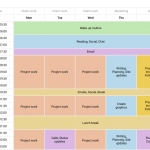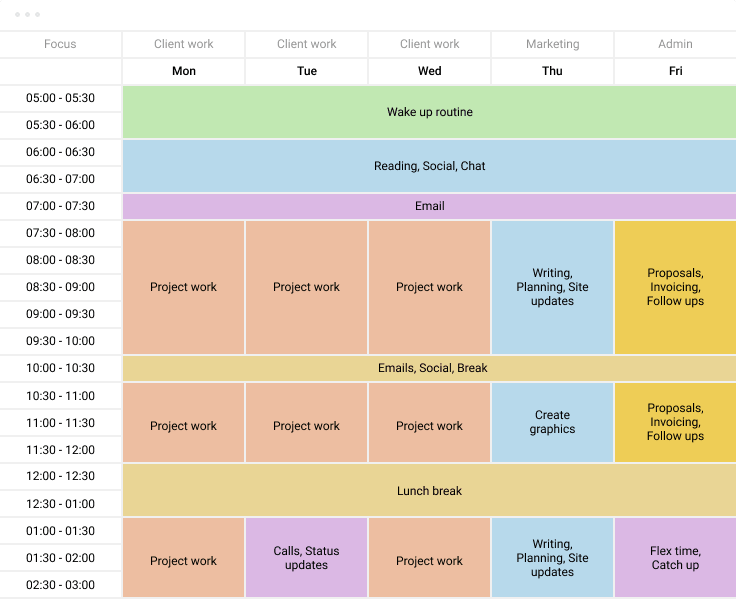
The internet today is filled with professionals who claim to have a recipe for a successful, deadline-crushing workday. And usually, they’re these idyllic daily routines and practices riddled with juggling countless productivity apps.
However, sometimes the simplest techniques can take us the farthest. Time blocking is one of them – an effective, easy to use method of organizing your schedule so that no task gets left behind.
In fact, learning how to schedule your day by time blocking will make you a productivity machine.
What is time blocking?
It is a time management technique where you set a specific amount of time to finish a single task or activity, and then schedule it into your calendar.
This way of organizing your schedule is widely acknowledged and praised by some of the most successful people across all industry spheres.
What makes time blocking so effective?
Whether you decide to use an app, write in a calendar or in a planner, the main advantage time blocking brings to the table is the self-discipline it teaches. When you have a time block like:
10:30 AM – 11:00 AM – Sort through email
You know that there’s half an hour for that particular task. No more, no less. If you happen to finish sooner – great! That’s buffer time you can spend on making coffee, checking personal messages or starting on the next task. Time blocking makes for a great framework that you have to adapt to. And it leaves little room for slacking. In a way, it becomes a rigorous master of your time that actually turns you into a productivity powerhouse.
Easy steps to master time blocking fast
This time management technique follows four straightforward steps. Employ this checklist every day, and you’re well on your way to crushing your daily workload.
- Comprise a list of all your tasks (for the day, or week);
- Sort your tasks within the time blocking schedule or template, assigning times along the way;
- Work on your tasks within the time block, aiming to complete them before the next one starts;
- At the end of the day, overview the schedule, learn from successes and mistakes, then rinse and repeat.

It really is just that simple.
That is the beauty of the whole technique. Time blocking is easy to pick up and forgiving enough for beginners who mostly learn through trial and error. And in the hands of professionals, time blocking is a formula for absolute success.
The best part is that you can customize time blocking to suit your personality and preferences. No two time blocking variants are the same.
Even though a journalist and a lifestyle blogger are in the same line of work, their time blocks will differ vastly! Additionally, some people like to use black and white bulleted lists, others time block in their online calendars, and there are also those who prefer a colorful time blocking app.
With a few tweaks here and there, you can transform your schedule into a personalized guide to your every workday.
The building blocks of time blocking
To really make the best use of this technique, you will need to adopt the following:
- Spend as much time as you can in the planning stage
- Have themed days
- Reserve empty time slots
- Use apps for greater efficiency
Let’s look at why each of these tips is crucial for successful time blocking.
1. Spend as much time as you can in the planning stage
The planning stage is crucial for time blocking. You need to be realistic about how many tasks you can take on, the factors that affect them (eg. commuting to work, waiting times, interruptions).
The first few times, scheduling out your days with these factors in mind will take you around an hour, if not more. But as you start doing this each and every day, you will gain enough insight to become more effective and quicker. By the end of the week, it could end up taking only half an hour! The important thing is to reflect on schedule at the end of the day to learn where you under- or overestimated your scheduling. It’s all about getting your finger on the pulse of the workday to try and make better time estimates.
The aim is to avoid the so-called “planning fallacy”. This a situation in which you devise a plan or a schedule with incomplete data. In the case of time blocking, you underestimate how long it will take you to finish certain tasks, or you overestimate your skills.
Like when you calculate that a road trip will take you a week, without taking into account the weather, your ability to drive for longer periods of time, and the possibility of traffic jams. Because the moment you start hitting those roadblocks, they will almost certainly kill your motivation and throw off the entire schedule.
To keep mistakes like these from happening, and to stay motivated as you try out time blocking, simply refine the schedules with each passing day. Keep good results in your routines, and tweak mistakes.
2. Create time blocks that revolve around similar work
Another good way of approaching time blocks is to organize them around specific aspects of your work. Some people with multiple roles at their job have found it easier to create schedules around a specific aspect of the job (or a project).
For example, on Mondays, they’ll focus on the bigger picture of the project management:
- emails;
- client and shareholder meetings;
- calls, and
- tracking the overall project performance.
On Tuesdays, their schedule might revolve around troubleshooting:
- meeting up with the QA department;
- talk to support;
- work on the newsletter;
- get updated on the performance of new product features, etc.
So, if you have the kind of job that allows you to devote an entire day (or just the morning or afternoon) to one particular aspect of it, consider doing that. It could help you focus better and ultimately get more done if all of the assignments are on the same spectrum.
3. Leave some time slots empty
Most of the time, keeping a few empty time blocks within the day is a godsend.
When has a day at work gone exactly the way anyone planned? Issues and unplanned tasks will crop up, and with a jam-packed schedule, you’ll have to cut something out to fit in an urgent matter.
That is why you’ll want to leave a time block or two per morning and afternoon. Being able to easily switch up between assignments keeps you more adaptable and prepared for unexpected situations.
4. Make time blocking more efficient with apps
You’ll be wondering how you managed your days before them.
Clockify
Clockify is a time tracker that can be used as a time blocking app that integrates perfectly with many other productivity tools. Once you make a time block within the calendar, you’re able to start the timer from the browser and let it do its work. The moment you’re done, just stop the timer and voila – task finished!
The bonus with this app is it enables you to track how the time blocking is going through weekly reports on the tasks you did and time spent on them. This can help with perfecting your planning skills for the future and avoiding planning fallacy.
Google Calendar
Google Calendar is a well-known app of choice for millions of users worldwide. Its layout is straightforward, easy on the eyes and very customizable. With a few clicks, you can note down any task, set a time block, and color-code it to your liking. You can set it to a daily, monthly or weekly view, add tasks, reservations, and events directly from Gmail, as well as add personalized goals (e.g. write five reviews this week).
The takeaway
There is so much more we can discuss about time blocking. It is not just an invaluable time management technique, but an important tool for learning self-discipline as well, both of which are crucial for productivity. It has a foolproof three-step formula – writing out tasks, setting time blocks for them, and filling out your schedule.
In all its simplicity, time blocking is the key to a productive workday. You need nothing more than a calendar or a notebook, a time tracking app, and some patience to master your own schedule.
About the author
Marko Maric is a marketing manager who has mostly been working with startups. His main goal has always been to make sure that the whole team is working as a unit aimed at delivering predefined marketing goals in the most effective and efficient way.




Time blocking is an excellent method of time management. I use it all the time to manage my work. I like #2 above as well since that is something I hadn’t thought of before!